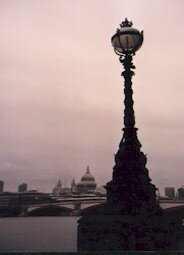History of London continued
Civil War & The Georgian Period
The London of 1665 had become one of the principal cities of Europe, with a population approaching a then massive 500,000 and notable landmarks such as St Paul's Cathedral and Westminster Abbey dominating an increasingly impressive skyline. Little did Londoners know, however, that a double tragedy was about to bring this newly-crowned 'greatest city in Christendom' to its knees.
 |
"But Lord, how empty the streets are, and melancholy, so many poor sick people...so many sad stories overheard, everybody talking of the dead." So wrote the diarist Samuel Pepys in the London of 1665, as the last Great Plague raged through the summer months and carried away a staggering 100,000 dead. Sparing no class, sex, or race, the rat-borne epidemic devastated whole communities and made all but subsistence living possible for many Londoners.
Barely as the city recovered from the devastations of the Plague, the Great Fire of 1666 raged from a small baker's shop in Pudding Lane throughout whole riverside districts, destroying 13,000 houses and 90 churches, including St. Paul's. Paintings of this disaster show the whole London skyline enveloped in flames and the sky glowing orange as the fire burned unabated for five days and nights. (The site of the initial fire is today marked by the towering Monument, a short stroll from Monument Station).
That London recovered and prospered in the years following these twin calamities is testament to the spirit and confidence of the city that was soon to become the capital of an Empire. Georgian London became the elegant city of broad terraces and manicured parks - many of which survive today. Painters, sculptors, and craftsmen flocked to London in the eighteenth century to meet the demand of the aristocracy and the Royal Court for inspiration and patronage, sparking a mini-Renaissance.
City of Empire
The consolidation of London as the pre-eminent city in the world was completed in Victorian times, as the British Empire expanded across the globe to incorporate India, Australia, New Zealand, Canada, and many other colonial outposts. Much of present-day London is in fact Victorian - terraced houses became common-place at this time, and previously outlying villages such as Islington and Highgate were absorbed by the rapidly expanding city limits. (The excellent Museum of London 'World City Galleries' and the V&A's 'British Galleries' showcase this great period in London's history).
Victorian London was a place of great wealth and poverty - the contrasts being vividly drawn by writers such as Charles Dickens and playwright Oscar Wilde. 19th century London was a city of Empire - hosting the Great Exhibition in 1851, opening the first underground train line in 1863, establishing great museums such as the V&A and British, and acting as the administrative and political heart of an empire that at its peak was to include more than a quarter of the world's population.
|





